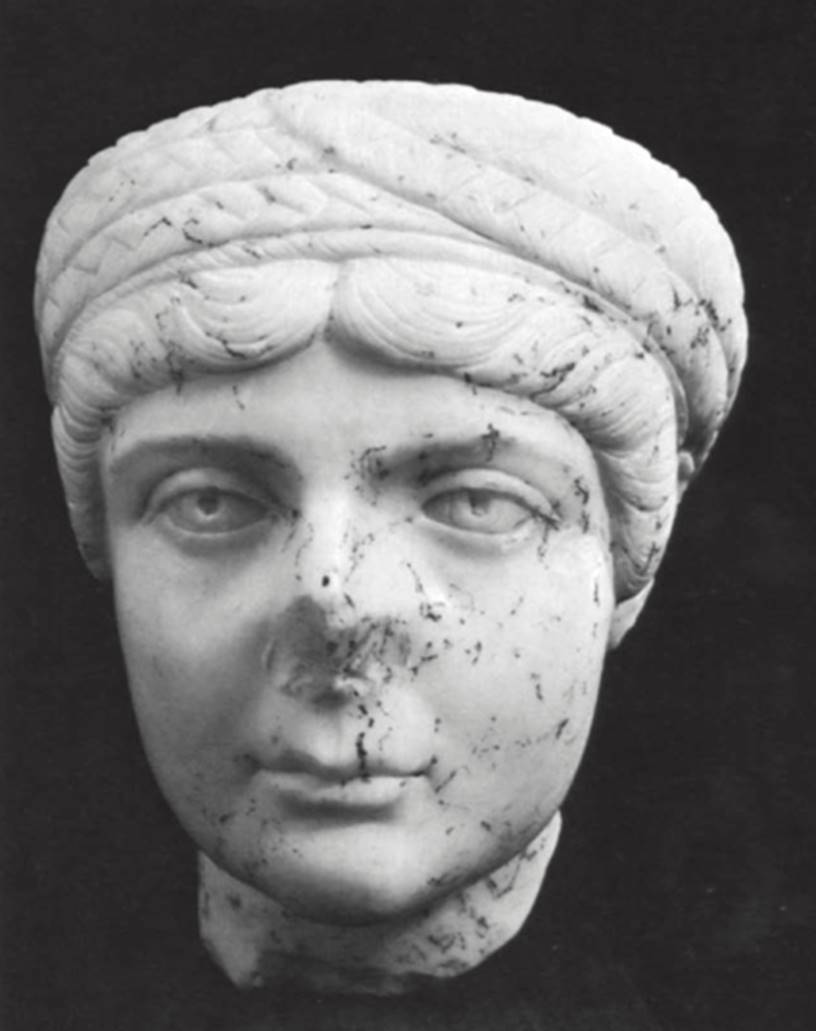Head of a lady. Constantinople (?), about 370-380. Marble
The finely polished marble head is broken off at the neck at an angle that suggests it originally gazed upward, as confirmed by the placement of the drilled pupils and incised irises on the eyes. The end of the nose is broken off, but otherwise, no significant damage.
The subject is a young woman with strong brows, cupid's-bow mouth, and compact ears; brows are incised into slightly raised supraorbital ridges. Her hair is parted in the center, combed in undulating waves over the ears, and wrapped in a coronet or turban of three tight braids. This coiffure, coupled with the smooth, modulated surfaces of the skin and the subtle asymmetries of the whole, link this portrait with the finest Antonine portraiture. Yet other traits, especially the visionary gaze, the precious quality, even the slightly diminished scale, are more characteristic of a later classicizing period, when Antonine portraiture was being imitated.

Vermeule's identification (1960) of the subject as Constantia, sister of Constantine and widow of Licinius, has met with much acceptance, although it has also been challenged—most firmly by Harrison (1967) and then von Sydow (1969), both of whom see the head as authentically Antonine. There is, in fact, some difficulty in placing this portrait among the various phases of Constan- tinian sculpture; Vermeule's (1960) solution, to attribute it to Athens, seems improbable in view of the political history of the period. The classicistic style seems entirely too delicate for the first half of the fourth century. The portrait was probably executed in the second half of the fourth century. Its closest counterpart here is no. 18, the portrait of Gratian, which shows the same delicacy of surface and even the same incised eyebrow treatment. Both heads have a similar spherical compaction of form rather than the oval construction of heads in Theodosian sculpture. The high polish, played off against the contrasting, delicately incised lines —as in the hair—is equally similar.
The coiffure has some resemblance with that of a head from Ephesus, dated to about 400 by Inan and Rosenbaum (1966, no. 190), while other less exact correspondences were used by von Heintze to assign this head to a group of female portraits she dated between 360 and 390 (1971). The ladies of this group have no specific attributes of rank, although Vermeule suggested that the coiffure itself imitated the coronet, and hence was reserved for ladies of imperial rank.
The work is said to have come from Greece. Bibliography: Vermeule, 1960; Harrison, 1967, pp. 87-88; von Sydow, 1969, p. 152; von Heintze, 1971, pp. 78-83; Calza, 1972, no. 181; Boston, 1976, no. 118.
Date added: 2025-08-31; views: 78;
